EMMA HELFRICH
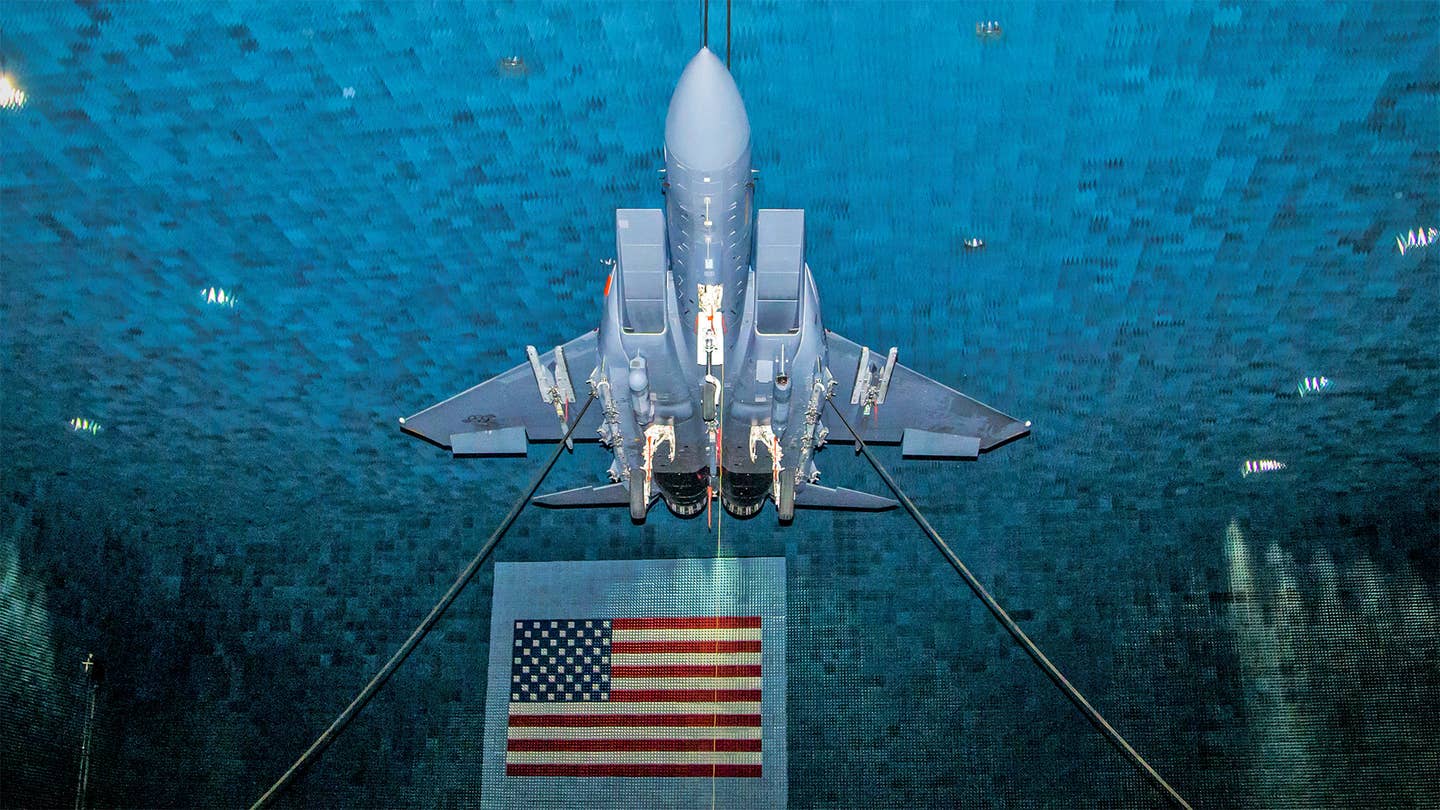
Col. Josh Koslov, commander of the U.S. Air Force’s 350th Spectrum Warfare Wing, and his team are laser-focused on dominating and winning in the electromagnetic spectrum.
While anything but new, this invisible battlespace has taken on a whole new level of importance as the United States pivots to confronting peer-state threats. Having only been stood up a little over a year and a half ago, and with Col. Koslov having taken on the wing commander role even more recently than that, not much is known about the 350th and its critical and fascinating mission. Now we hope to change that.
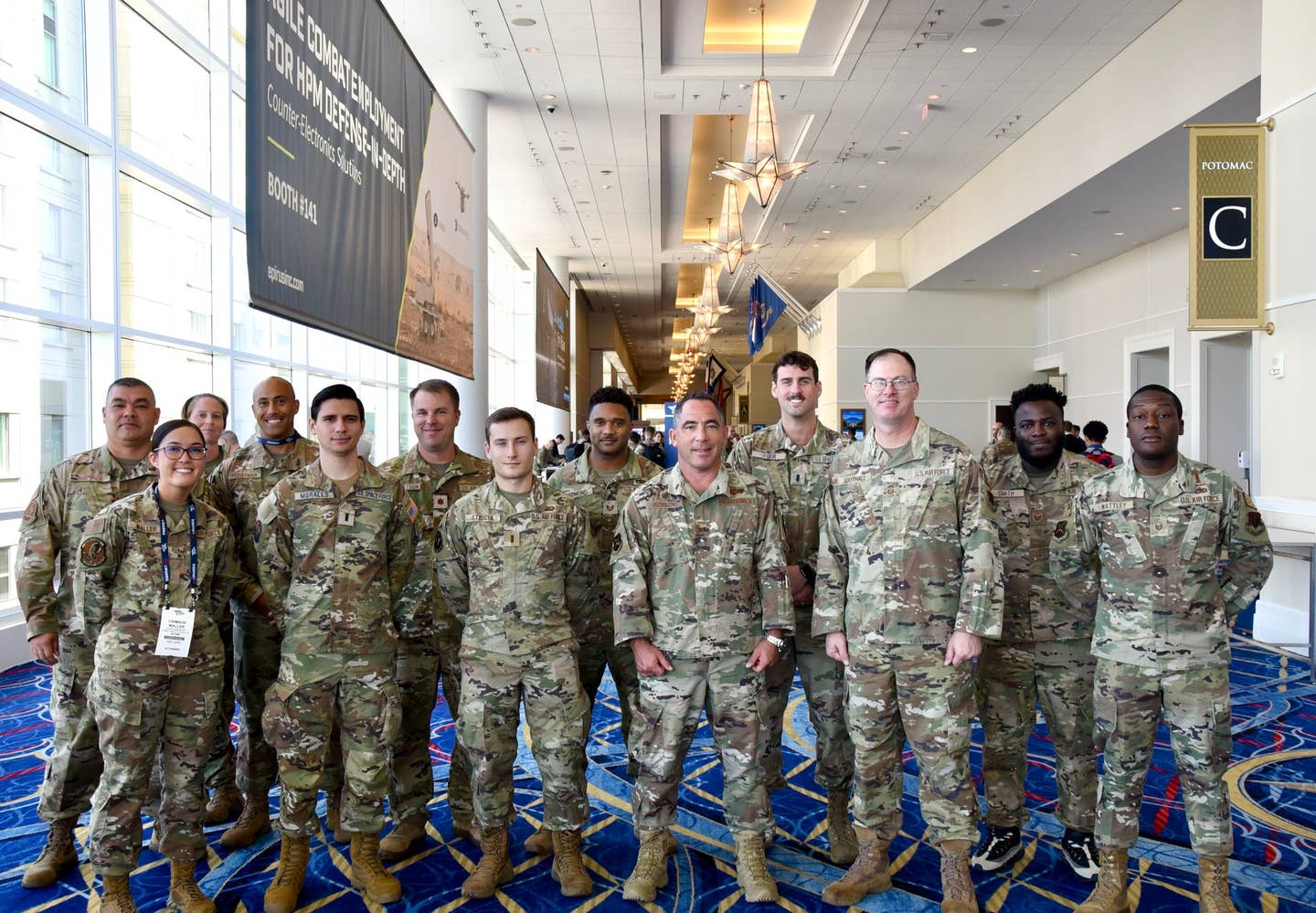 Members from the 350th Spectrum Warfare Wing at this year's Air Force Association Air, Space, and Cyber Conference in Washington, D.C. Col. Koslov can be seen front and center. Credit: 350th SWW
Members from the 350th Spectrum Warfare Wing at this year's Air Force Association Air, Space, and Cyber Conference in Washington, D.C. Col. Koslov can be seen front and center. Credit: 350th SWWIn June of 2021, the Air Combat Command activated the 350th Spectrum Warfare Wing, cementing it as the first of its kind. The wing is centered around leveraging the engineering know-how of its personnel to better develop the technologies and capabilities needed to improve the Combat Air Force’s presence on and exploitation of the electromagnetic spectrum (EMS).
While aerial electronic warfare is a central focus, it recognizes that the EMS spans all domains and is a key component of the U.S. military’s Joint All-Domain Command and Control (JADC2) initiative as well as its broader interoperability efforts. The wing provides EMS capabilities for 69 United States and foreign partner electronic warfare systems on top of being responsible for electronic warfare reprogramming and overall development.
In July of this year, Col. Koslov took command of the 350th and since then, the wing has reached a number of milestones, including the activation of a digital networking service dubbed Wavelength and the conceptualization of the Reclamation of Electronic Attack Pods (REAP) program. In fact, reprogramming the electronic warfare pods and systems on various Air Force aircraft is a key part of what they do, and it’s a very serious business as the protection those systems provide can mean life or death for an airframe and its aircrew — if it has one — during a combat mission.
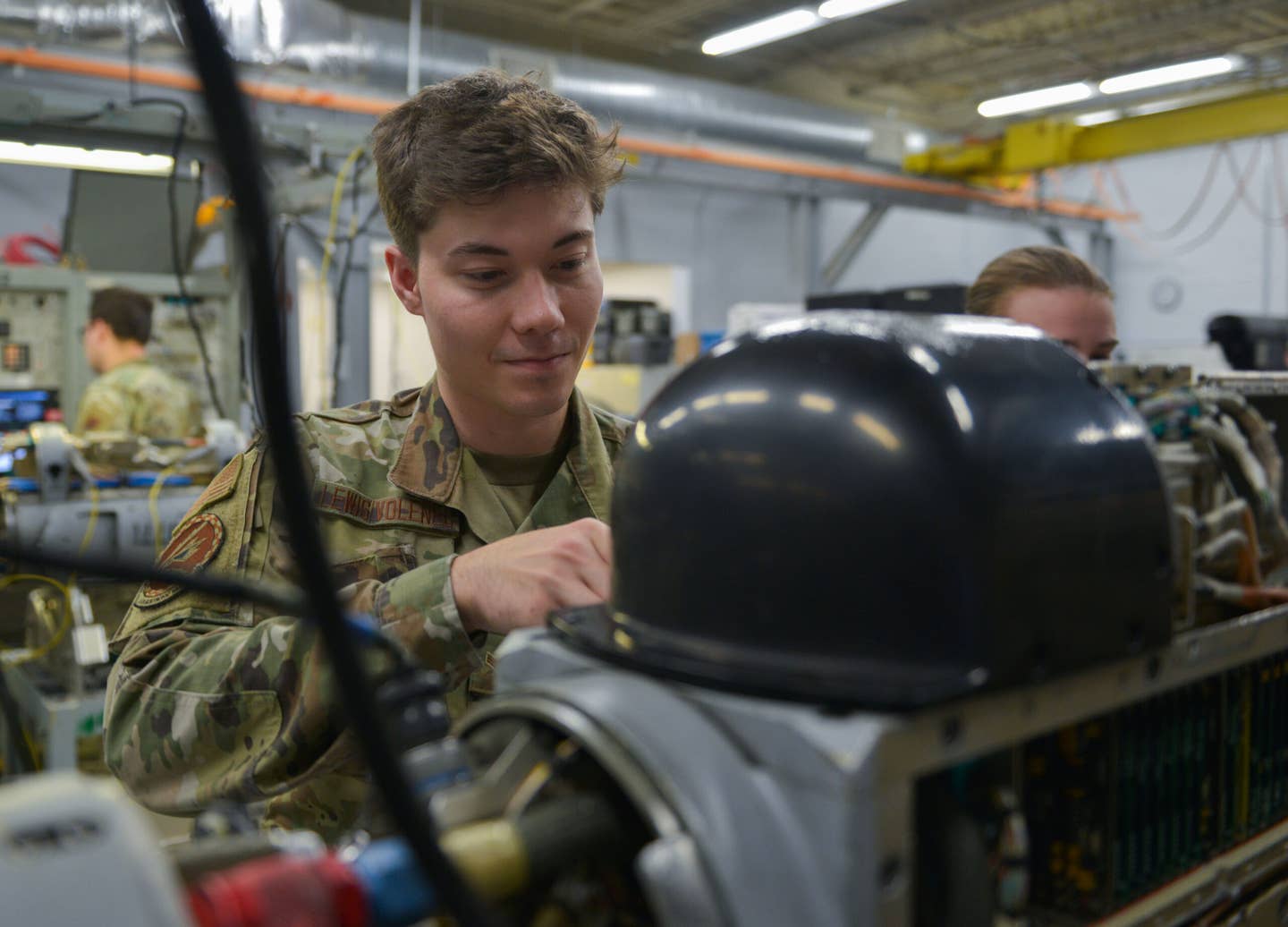 Airman 1st class Phaelan Lewis-Volenec, 36th Electronic Warfare Squadron technician, de-panels an AN/ALQ-184 Electronic Attack Pod for the REAP program at Eglin Air Force Base, Fla., Sept. 14, 2022. Credit: U.S. Air Force photo by Staff Sgt. Ericka A. Woolever
Airman 1st class Phaelan Lewis-Volenec, 36th Electronic Warfare Squadron technician, de-panels an AN/ALQ-184 Electronic Attack Pod for the REAP program at Eglin Air Force Base, Fla., Sept. 14, 2022. Credit: U.S. Air Force photo by Staff Sgt. Ericka A. WooleverHowever, there is far more to the 350th and the role it will play in future conflicts where the EMS will be heavily contested and exploited by everyone involved. Compared to missiles, aircraft, or traditional intelligence, the somewhat intangible nature of combat within the EMS makes it challenging to easily convey and truly appreciate how important fighting to win in it has become.
With that in mind, we talked in-depth with Col. Koslov about the still new Spectrum Warfare Wing he commands, and where the invisible fight that turns electrons into weapons is headed.
TWZ: Could you explain the evolution of the 350th and how it got to where it is now over the last year and a half or so?
JK: I think right now in the electromagnetic spectrum operation space it’s a really good time for optimism. In terms of history that impacts the 350th, the Air Force did the Enterprise Capability Collaboration Team (ECCT), which was focused on electronic warfare on the spectrum. And then the Defense Department came out with the electromagnetic spectrum operations (EMSO) strategy, and so from those documents and those studies, there was an understanding that there was a lack of organizational structure to focus on spectrum operations.
The really cool part is that the Air Force split up an electromagnetic security operations directorate on the headquarters Air Force side, and then they built this wing. This wing was built out of what was the 53rd Electronic Warfare Group under the 53rd Wing at the Cyber Warfare Center at Nellis Air Force Base, and it was a test organization.
We set up the wings based on the bones of the Air Force's reprogramming mission. And so the 350th stood up a little over a year and a half ago as an official wing, and we're still in the process of growing. As of right now, we're going to have three groups focused on different aspects of spectrum operations.
Another part of the optimism is that now there's an organization that is period-dot-focused on EMS capabilities, development to support Air Component Commanders, and their need to win the fight that they're in.
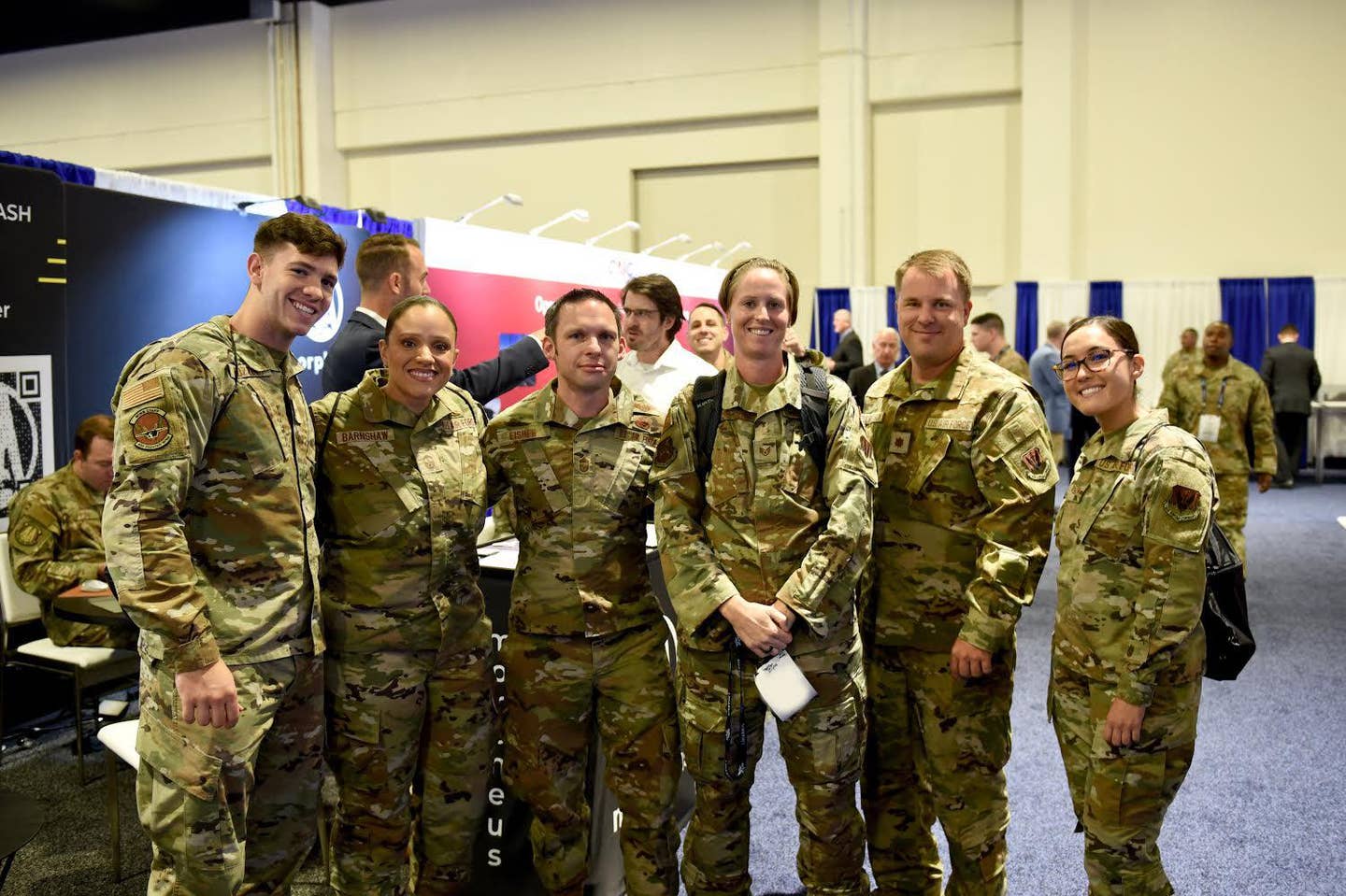 Members of the 350th Spectrum Warfare Wing while attending the Air Force Association Air, Space, & Cyber Conference in Washington D.C. Credit: 350th SWW
Members of the 350th Spectrum Warfare Wing while attending the Air Force Association Air, Space, & Cyber Conference in Washington D.C. Credit: 350th SWWOne of the problems in the spectrum environment is that we focus on widgets, and what we're really trying to do here is focus on the warfighter and the gaps and seams in how we approach combat in support of Air Component Commanders' objectives.
We are a functional wing, an Air Combat Command functional wing, assigned to the Warfare Center, the U.S. Air Force Warfare Center, but we really feel that we support Air Component Commanders who are supporting Joint Force commanders in our geographic combatant commands, i.e. supporting PACAF, we support USAFE, we support AFSEC, and we support AFSA. To do that, we have three operations groups:
The first operations group is the 350th Spectrum Warfare Group, and this is a really awesome organization. They're kind of your core, coming out of that 53rd Electronic Warfare Group that I discussed earlier, and they do right now what we traditionally call mission data or reprogramming. They do that for over 70 systems for over 40 countries and are really hardcore engineering outfits.
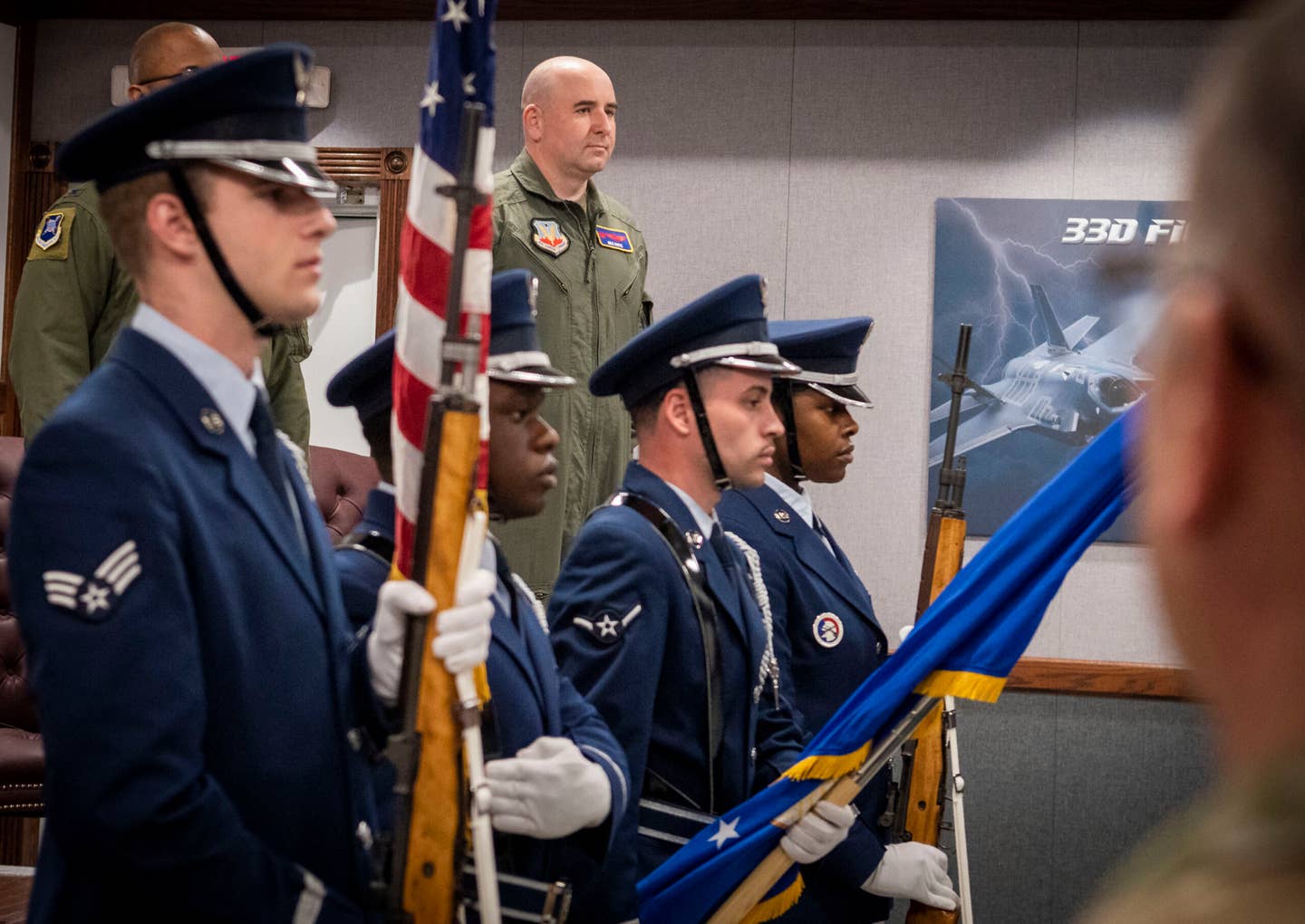 Col. Robert Cocke stands at attention for the national anthem during the 350th Spectrum Warfare Group assumption of command ceremony at Eglin Air Force Base, Fla. March 18, 2022. Credit: Air Force photo by Jaime Bishopp
Col. Robert Cocke stands at attention for the national anthem during the 350th Spectrum Warfare Group assumption of command ceremony at Eglin Air Force Base, Fla. March 18, 2022. Credit: Air Force photo by Jaime BishoppTheir purpose is to make sure that our platforms and our systems are survivable and have the most up-to-date information for the battle spaces that we face in the future. That's their job. We're looking to modernize that capability.
In the past, that has been a very stovepiped capability focused on individual platforms, and that business model is not going to work in the near-peer fights that we're going to have in the future. So we're looking to develop capabilities within that organization to be able to move quickly and more agilely reprogram the various systems that are out there in the world and to provide combat capability for their Air Component Commanders.
The second operations group is the 850th Spectrum Warfare Group, and their job is going to grow to target development. And basically, they are our identifiers of the gaps and seams and support our ability to do things in a virtual environment, and potentially, one day, waveform development using software development capabilities. They are a really cool organization and they are brand new, and they're really the future promise of what spectrum warfare can bring to an organization.
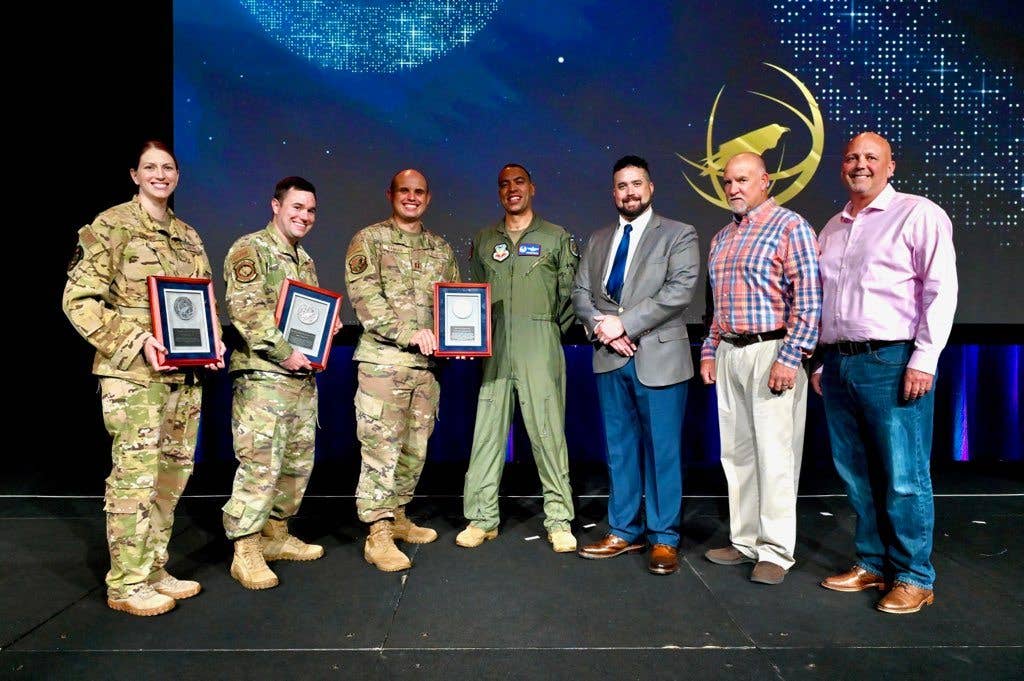 Members from the 850th Spectrum Warfare Group pose for a group photo after receiving awards presented to them by the Association of Old Crows (AOC) at the 59th Annual AOC International Symposium & Conference, Washington D.C., Oct. 26, 2022. Credit: U.S. Air Force photo by 1st Lt. Benjamin Aronson
Members from the 850th Spectrum Warfare Group pose for a group photo after receiving awards presented to them by the Association of Old Crows (AOC) at the 59th Annual AOC International Symposium & Conference, Washington D.C., Oct. 26, 2022. Credit: U.S. Air Force photo by 1st Lt. Benjamin AronsonAnd then finally, the next piece is the 950th Spectrum Warfare Group. That's going to be a new operations group. We're just starting work on that. It's going to be located at Robins Air Force Base, Georgia. We're growing that mission to be our assessment capability for the Air Force's EMS operations. Right now, we assess individually based on platforms, based on very specific systems on platforms, but we want to grow this operations group to provide a much better view of how the Air Force would perform in the spectrum in an operational environment, and that’s the 950th.
What our wing does, the 350th Spectrum Warfare Wing, our job is to provide monitoring, programming, its to provide target development, and its to provide the assessment to Air Component Commanders.
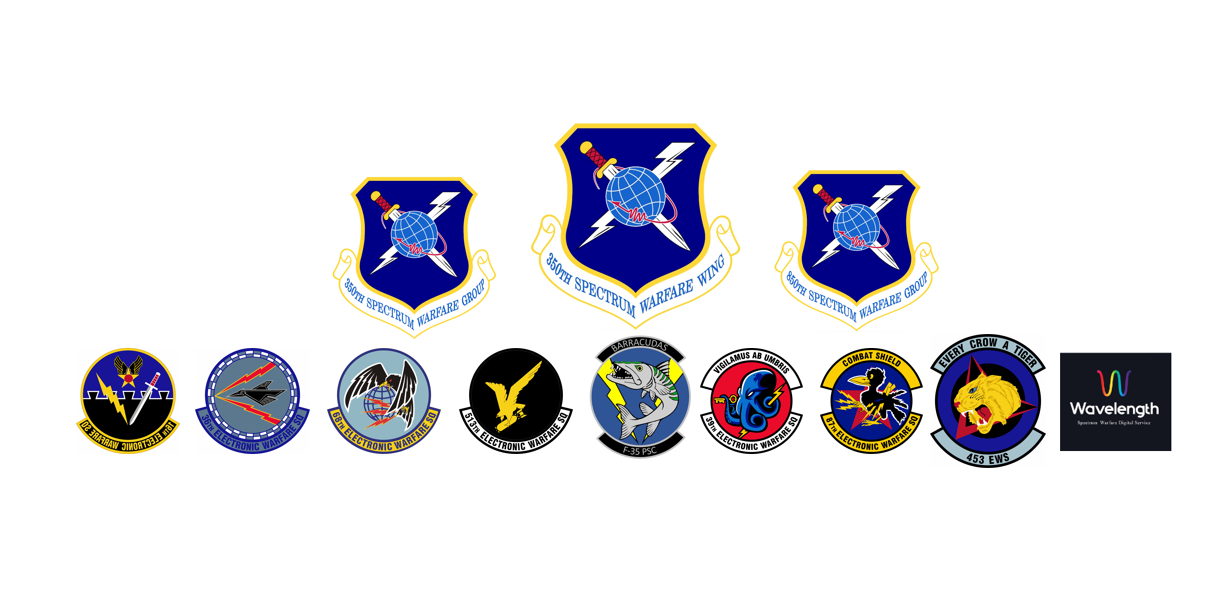 Patches belonging to the 350th Spectrum Warfare Wing as well as the groups it oversees. Credit: 350th SWW
Patches belonging to the 350th Spectrum Warfare Wing as well as the groups it oversees. Credit: 350th SWWTWZ: The 350th’s activation was described as an Air Force effort to build back electronic warfare and EMS capabilities after years of letting them atrophy. Could you speak to why these capabilities atrophied in the first place, especially considering how modern warfare has evolved to increasingly occur in the spectrum and will only continue to do so?
JK: That is a delicate one that I had to think about. Really, the answer is that our eyeballs are focused not on the near-peer, quite frankly. If you look at what EMS assets did in the counterinsurgency wars that we fought over the past 25 years, they did phenomenal work, but we took our eyeballs off the high end.
And then we lost because of organizational stovepipes, we lost the ability to look across all of our platforms, and to use the information to inform not only the development but the application of electronic warfare capabilities across the airforce writ large and with our joint coalition partners as well.
I’m talking specifically about the Air Force, but one thing I always like to stress is that the spectrum is inherently joint and it's also inherently coalition. We kind of always have to have that mindset as we develop the capability for it.
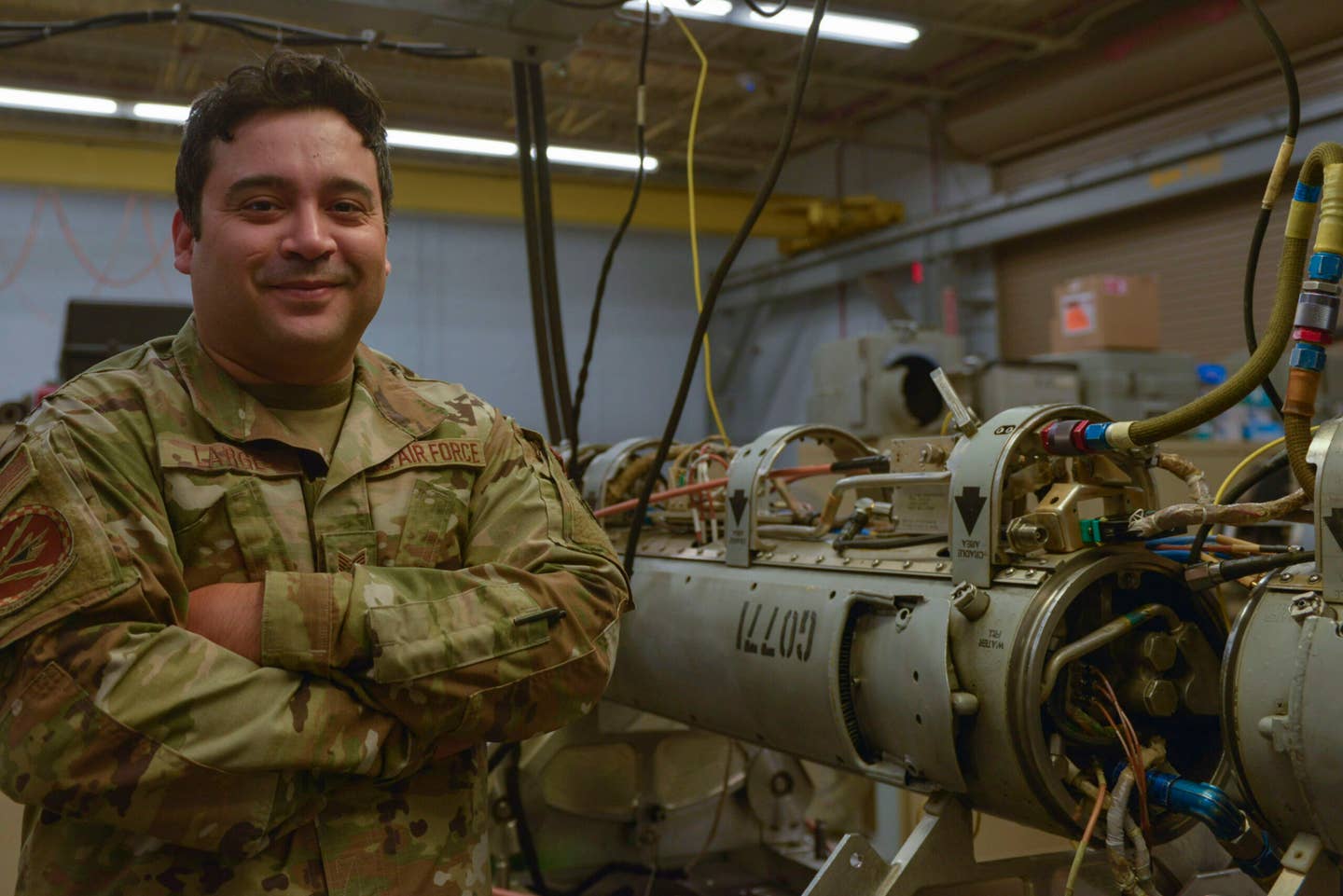 Staff Sgt. Harvey Large, 36th Electronic Warfare Squadron legacy lab section chief, poses for a photo in one of the wing's workshops used to develop new and improved EMS capabilities. Credit: U.S. photo by Staff Sgt. Ericka A. Woolever
Staff Sgt. Harvey Large, 36th Electronic Warfare Squadron legacy lab section chief, poses for a photo in one of the wing's workshops used to develop new and improved EMS capabilities. Credit: U.S. photo by Staff Sgt. Ericka A. WooleverTWZ: What would you say is the biggest obstacle EMS capability development needs to overcome right now?
JK: There are a lot of people that are working on this. In the headquarters Air Force, they are working on a sprint methodology to get after some specific things, but what I'd offer you is that the spectrum touches each of the Secretary's operational imperatives prioritizing the things that are really important. For us, that is: What are the targets that the spectrum has to account for in order to make sure that our kill chains are effective and meet the commander's intent?
How do we develop our people to not only put them in places where they can advocate for the resources and requirements but to be able to integrate these capabilities into the warfighting commands? Which is also very important.
The next thing is that we have to get to a place where we can use all of the data available to us across classification levels in a much easier fashion. So, breaking down some of the policies and interoperability barriers that exist.
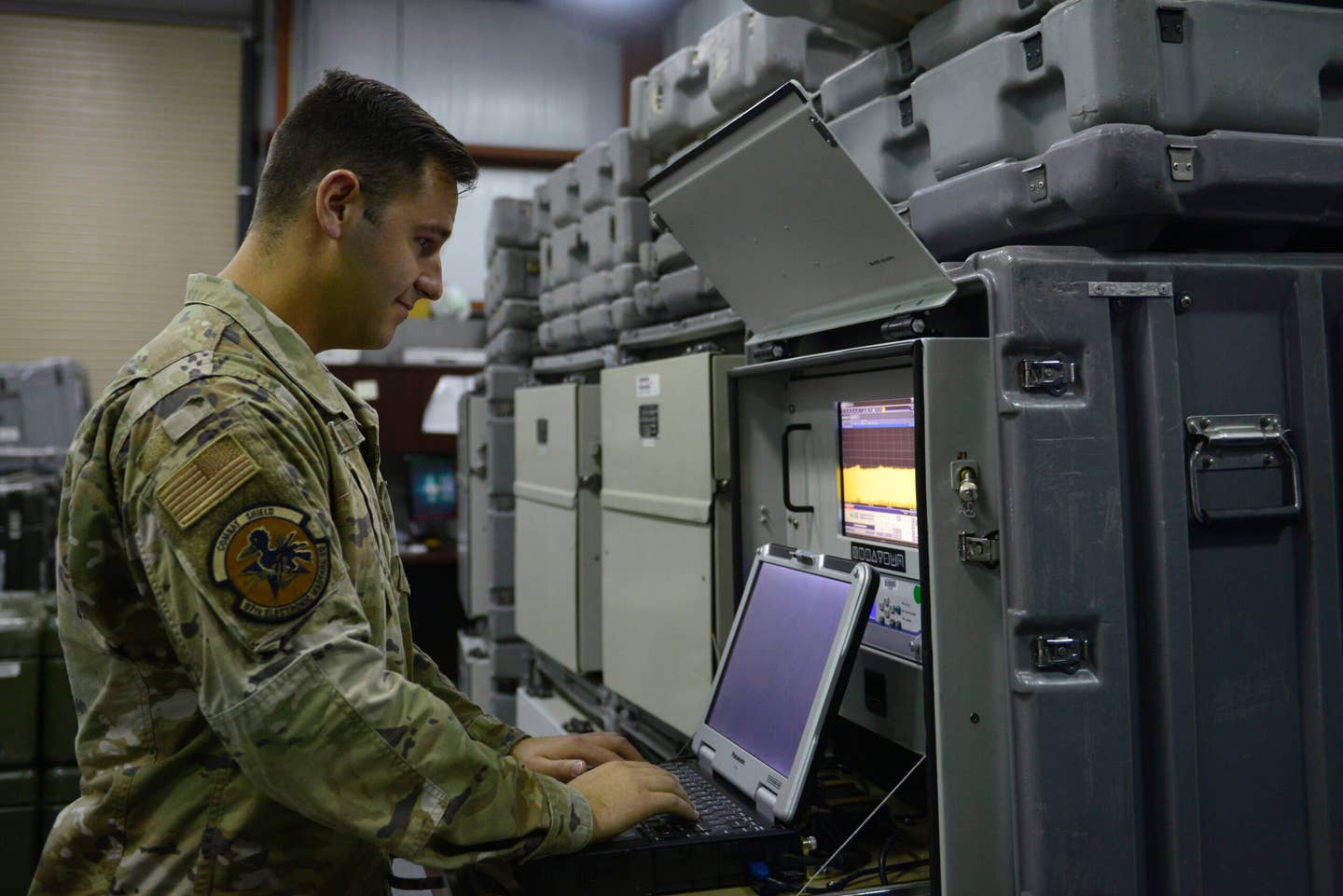 U.S Air Force Staff Sgt. Preston B. Leeling, 87th Electronic Warfare Combat Shield technician performs a software verification on a USM-642 Raven Test set at Eglin Air Force Base, Florida, August 29, 2022. Credit: U.S. Air Force photo by Staff Sgt. Ericka A. Woolever
U.S Air Force Staff Sgt. Preston B. Leeling, 87th Electronic Warfare Combat Shield technician performs a software verification on a USM-642 Raven Test set at Eglin Air Force Base, Florida, August 29, 2022. Credit: U.S. Air Force photo by Staff Sgt. Ericka A. WooleverTWZ: An Air Force officer once said to me that ultimately what electronic warfare (EW) capabilities buy you is time and sometimes that's all you need. Would you agree with that statement? Or would you say there is a disconnect among the Defense Department regarding EMS capabilities because they aren't as ‘sexy’ or as tangible as missiles and smart bombs?
JK: I 100% agree with that being something that EW could do, but I think it's far to the right of what we can do. What the promise of the Spectrum Warfare Wing is and what talking to you is, frankly, and the EMSO sprint that I talked about is, is that a development of a professional workforce and the development of EMSO professionals that understand that the EW spectrum can be used to achieve the commander's intent.
If we focus on the end game, we're going to lose. But if we can use the spectrum to focus far left of the kill chain and break the kill chain before we get to having to buy ourselves time, that's where we need to be and that's how we're going to win. That's the capability that we have to develop.
That could be developing an information advantage or decision advantage by preventing adversary decision-makers from receiving information. But that could also be breaking holes in integrated air defense systems (IADs) that allow our strike package or weapons to get to their targets.
TWZ: A strong presence on the EMS is projected to be a predominant facet of a potential conflict with China especially, and some are not confident that we're ready in that respect, considering China's own advancements. Would you agree and if so, what would you say we need to be considered ready? And if not, why do you think some people feel that way?
JK: There's a lot there and the way I’d answer that is I have focused our organization 100% on our pacing challenge, which is China. And we have to continue to get better. The spectrum is going to be the most contested domain, and we have to have the opportunity and the ability and the capability to fight through challenges in the spectrum and to be able to have spectrum security or spectrum dominance when we need it to be successful.
TWZ: How will various platforms carrying disparate electronic warfare payloads across multiple domains collaborate to realize broad EMS effects like never before?
JK: That's all tied into the Secretary of the Air Force's operational imperatives, but obviously JADC2 is a very important piece of this. There are also things that are being worked on called electromagnetic battle management. The ability to command and control how we're sensing and then attacking through the spectrum is going to be critical to this effort, and developing the capability, the people that understand that, the technologies that support the people to make that happen, and developing the technologies that allow that to happen without the human factor are also super important.
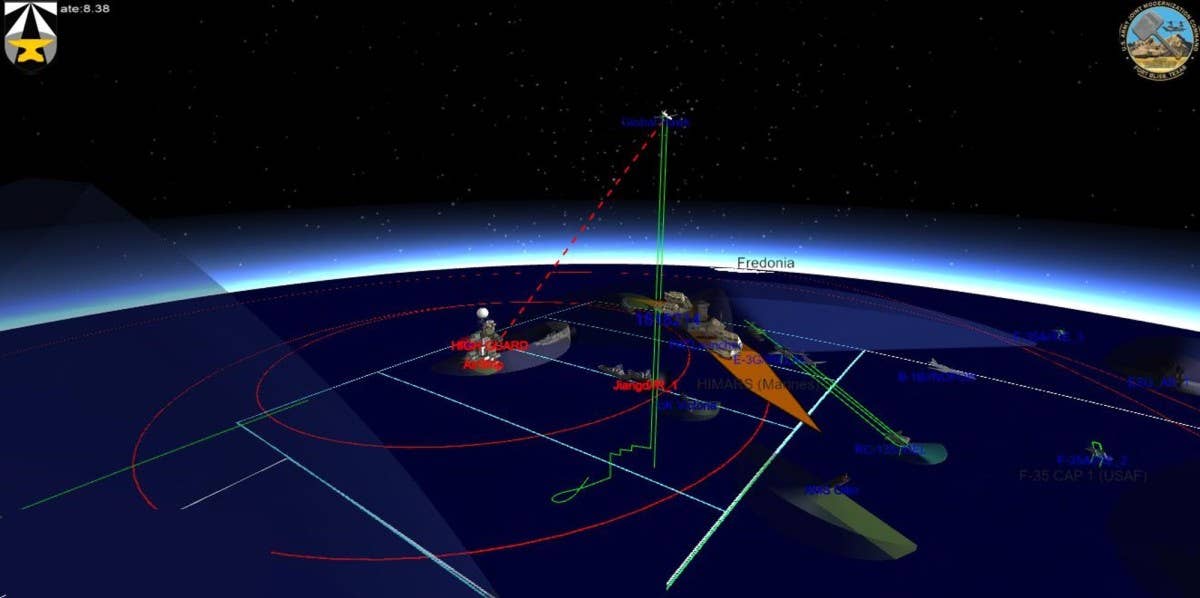 The Joint Staff’s Joint All-Domain Command and Control Campaign Plan Experiment 2 in 2020 allowed Army, Navy, Air Force, and Marine nodes to share near-real-time information to enable sensor-to-shooter linkages and display it on a common operational picture. Credit: U.S. Army Joint Modernization Command)
The Joint Staff’s Joint All-Domain Command and Control Campaign Plan Experiment 2 in 2020 allowed Army, Navy, Air Force, and Marine nodes to share near-real-time information to enable sensor-to-shooter linkages and display it on a common operational picture. Credit: U.S. Army Joint Modernization Command)TWZ: What would you say is being done to make, let's just call it cross-domain cooperative EW, a reality, and what would you say are the hurdles?
JK: This is new, right? This is an idea. It's a spectrum. The good and the bad of the spectrum is that it touches everything. The spectrum can achieve commanders’ objectives, it can integrate with capabilities like cyber or strike packages, or, in our traditional mindset, SEAD (suppression of enemy air defenses) platforms, to enable other types of assets to achieve commanders' objectives.
We are just at the beginning periods of technologically using a lot of these things, but it's doable, and we just have to have the right people developing the tactics, techniques, and procedures to make that happen. Then we have to be able to integrate that into Joint Force commanders' planning to make sure that those requirements are made known and then executed.
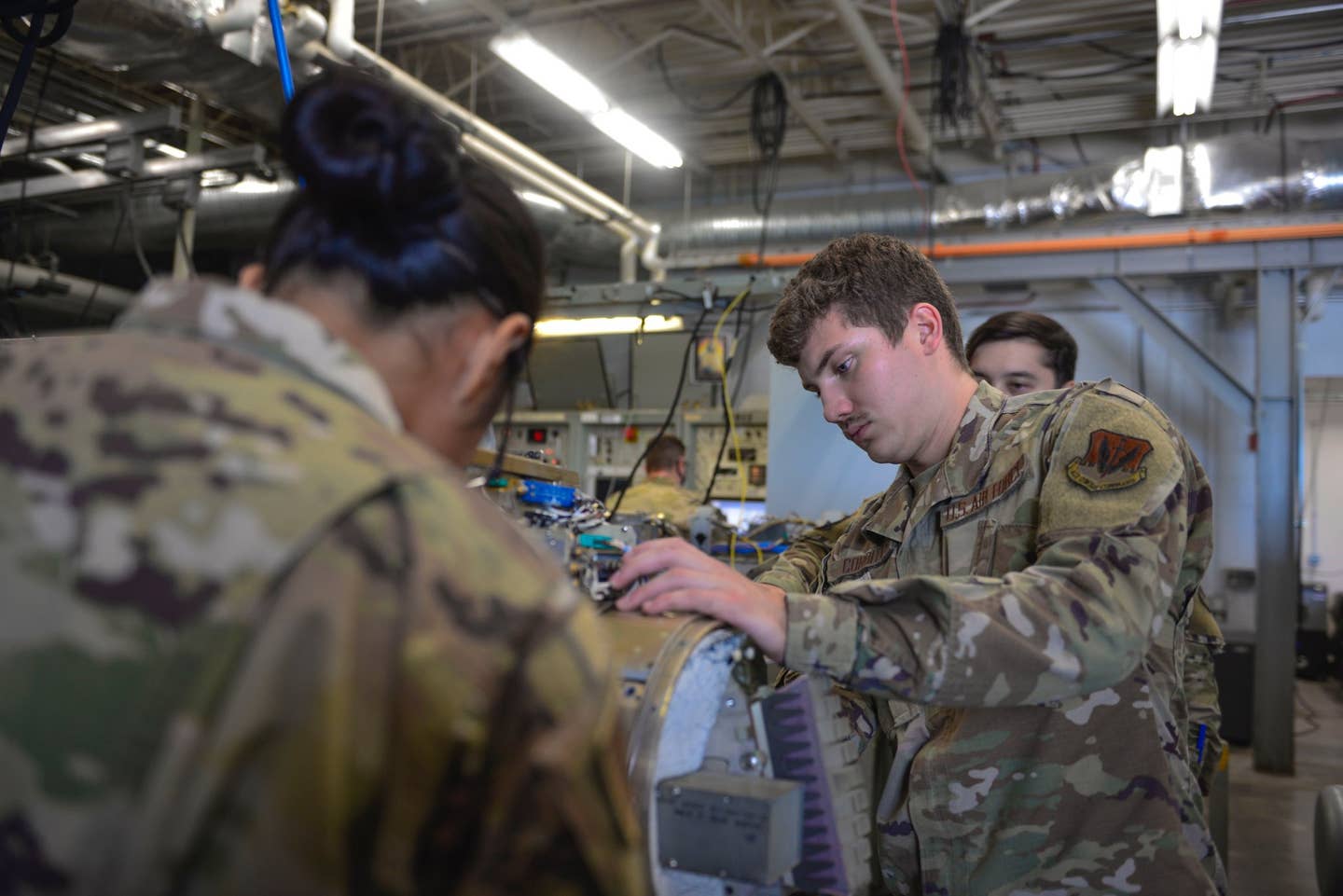 Members from the 36th Electronic Warfare Squadron work on an A4 module at Eglin Air Force Base, Florida, on August 29, 2022. Credit: U.S. Air Force photo by Staff Sgt. Ericka A. Woolever
Members from the 36th Electronic Warfare Squadron work on an A4 module at Eglin Air Force Base, Florida, on August 29, 2022. Credit: U.S. Air Force photo by Staff Sgt. Ericka A. WooleverTWZ: Can you explain cognitive EW and how you see it being applied on the battlefield? Is there a timeline for realizing such a capability, and what platforms and architectures could you see potentially leveraging it?
JK: Cognitive EW is definitely something that is a real thing. The Air Force has been doing it for a while. It's not new, it's just becoming more broadly well-known. I think that when you talk about a fight with a peer threat, specifically China, where we have to get to as a force, is to be able to do our mission at the edge in real-time. The way we're going to be able to do that is with tools that are capable of interpreting information quickly, and then being able to provide that information to the warfighter or the warfighter’s systems quickly.
To get there, we're going to have to invest in technology that provides a greater degree of autonomy, and we're going to have to accept and understand the risks and be able to test and validate those systems in a realistic, feasible way. That allows us to trust it.
TWZ: Is ‘cognitive EW’ a phrase that you feel accurately represents the technology it's describing?
JK: There is a potential for a buzzword aspect to that phrase. I don't want to have lexicon battles, but what I do need is a mindset that I can develop technology that says it looks like a duck, it smells like a duck, it's in bad-guy land, so I'm going to use this effect against it in order to be as quick as possible because all future fights are about speed. That's what I have to be able to do. If we're going to call that cognitive, that's fine. If we're going to call that algorithmic, that's fine. But at the end of the day, what I need to do is be rapid.
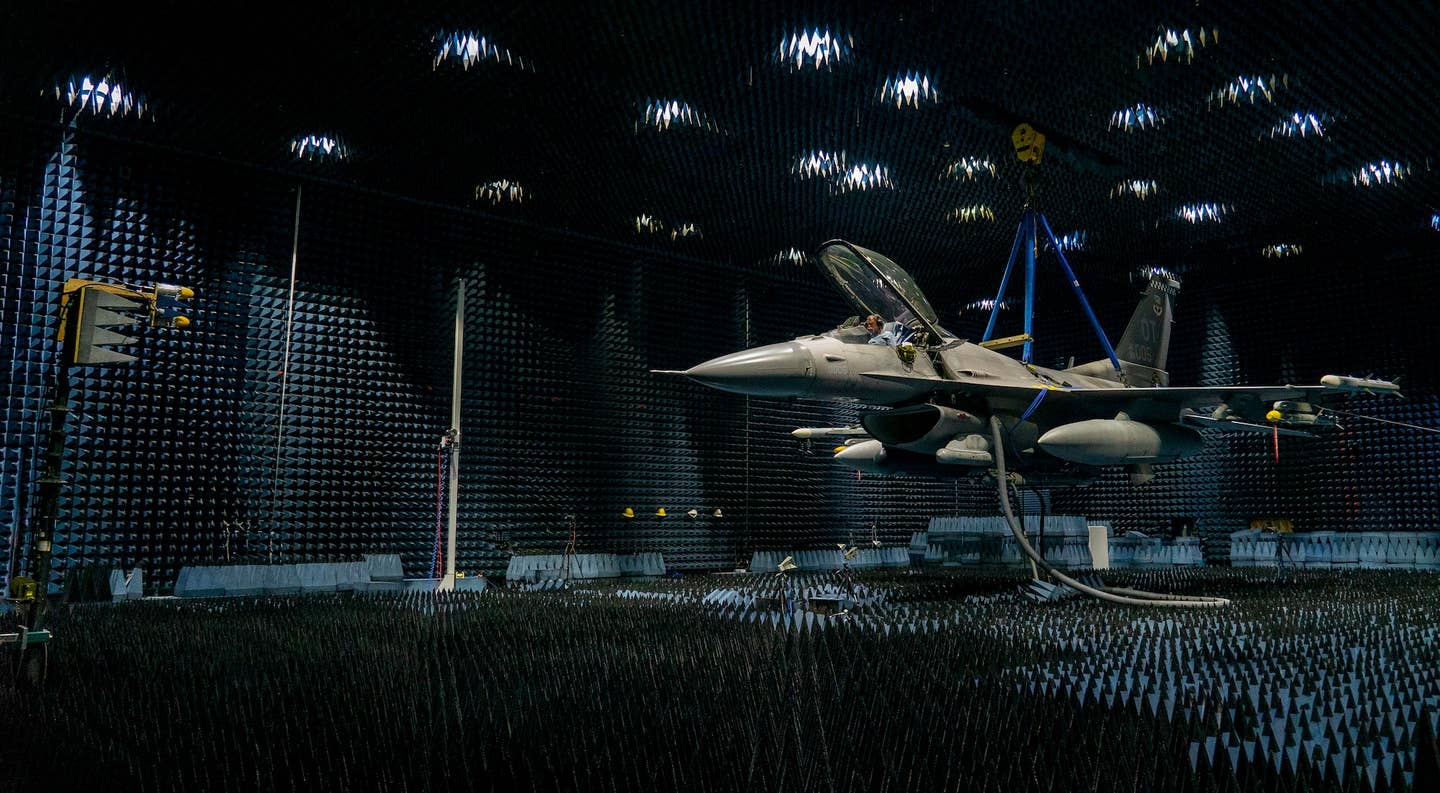 The Operational Flight Program Combined Test Force tested the Angry Kitten Electronic Countermeasures Training pod on board an F-16 Fighting Falcon to characterize interoperability of the Angry Kitten with other F-16 systems like the Fire Control Radar. Credit: U.S. Air Force photo/Tech. Sgt. John McRell
The Operational Flight Program Combined Test Force tested the Angry Kitten Electronic Countermeasures Training pod on board an F-16 Fighting Falcon to characterize interoperability of the Angry Kitten with other F-16 systems like the Fire Control Radar. Credit: U.S. Air Force photo/Tech. Sgt. John McRellTWZ: Stand-in jamming via drones is becoming a key tenant of the future of aerial warfare and surviving in a contested environment. How do you see this playing out in a future fight? Will air-launched EW-enabled drones providing stand-in jamming for manned or more advanced unmanned platforms be essential to winning in future combat environments?
JK: Where the jamming comes from I am agnostic, but if you're going to be successful in the whole kill chain from the far left all the way to the right, as I discussed earlier, you're going to have to have a mixture of stand-in and stand-off capabilities that provide the warfighter the ends that they need.
TWZ: As enemy-IADS networks improve, stealth technology will have to keep up, but historically, platforms that leverage it have also relied on EW for their survival. Do you see onboard and off-board EW capabilities being just as important for stealthy aircraft of the future as their radar and infrared evading features?
JK: 100% and that's the purpose of the 350th Spectrum Warfare Wing. We do that today, we're good at it, and we're going to keep being good at it.
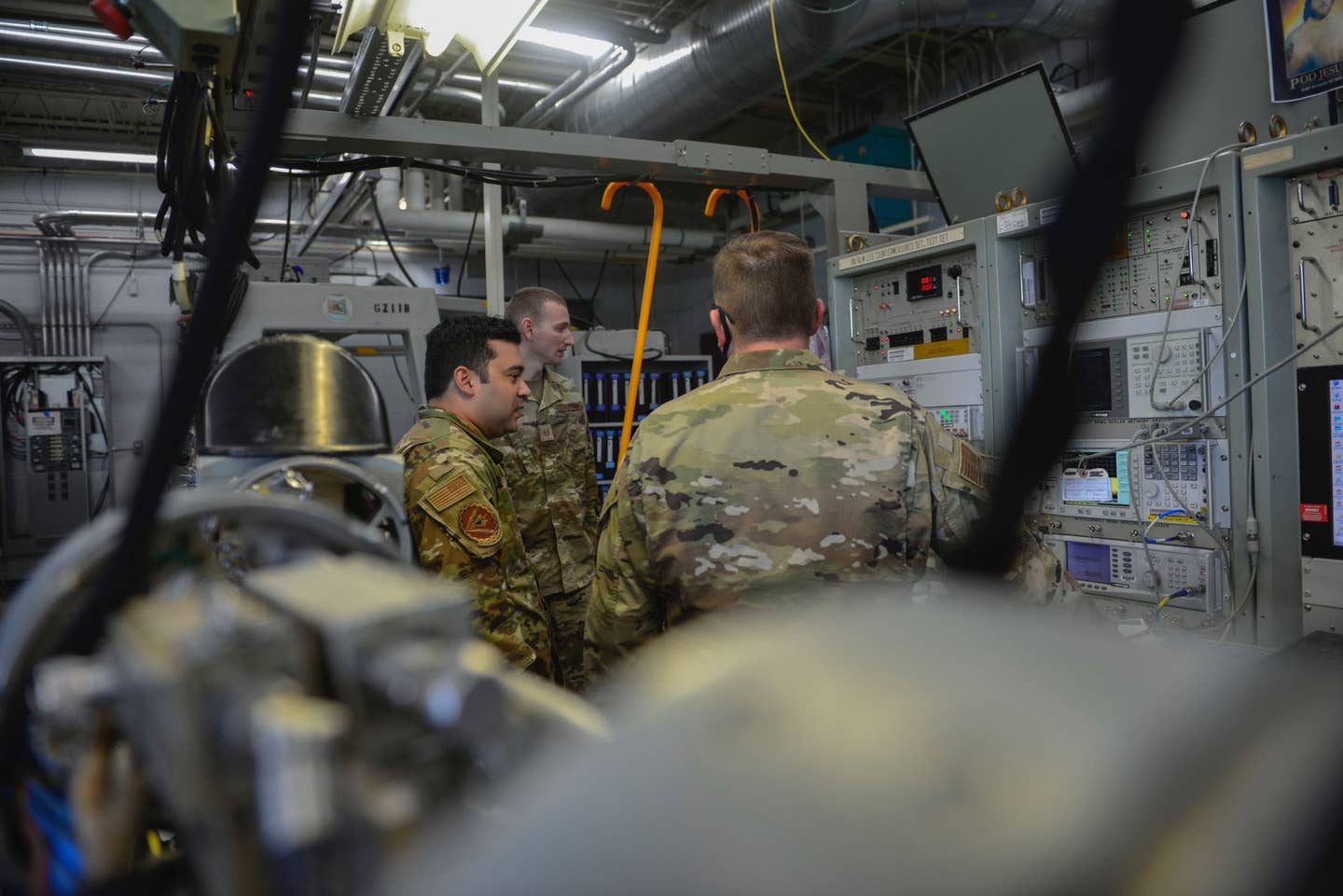 Airmen from the 36th Electronic Warfare Squadron calibrate automatic support equipment at Eglin Air Force Base, Florida, August 29, 2022. The 36th EWS provides missionized software for jamming and detection systems to ensure aircraft survivability. Credit: U.S. Air Force photo by Staff Sgt. Ericka A. Woolever
Airmen from the 36th Electronic Warfare Squadron calibrate automatic support equipment at Eglin Air Force Base, Florida, August 29, 2022. The 36th EWS provides missionized software for jamming and detection systems to ensure aircraft survivability. Credit: U.S. Air Force photo by Staff Sgt. Ericka A. WooleverTWZ: How will EW be implemented downrange in contested airspace? What about more advanced penetrating EW capabilities? Or how does, for example, the EC-37 a stand-off system based on a private jet fit into all of this?
JK: In the spectrum, there's not one answer. You need the capability to have that far-left capability and that stand-in capability, and you base it on what you need to achieve that day in support of the commander's objectives in the fight. It’s definitely based on science, but there's also an art of what systems are you taking down and what menu of capabilities are you bringing to achieve that objective and to affect that kill chain.
If we're in a war with China and our objective is to break through maritime-based IADS, we have to have the best mix of capabilities across platforms that allow our weapons to hit the target. If we can disable maritime IADS from the spectrum, that allows us to put kinetic weapons in different places. It's about the integration of warfighting capabilities.
No comments:
Post a Comment